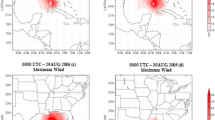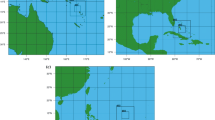Summary
Considerable advancements have recently been made in understanding tropical cyclone motion. Based on these new understandings, the requirements for accurate tropical cyclone motion prediction with dynamical models can be specified. Four issues related to dynamical track prediction are the initial specifications of the environmental wind field, the symmetric vortex and the asymmetric vortex structure, as well as the adequacy of the models to predict the time evolution of each of these three components of the total wind field. Recently developed barotropic and limited-region or global baroclinic models are examined in terms of these issues. The capability of the Hurricane Research Division barotropic model to provide skillful track forecasts to 48 h retrospectively substantiates that tropical cyclones motion is governed by barotropic dynamics to first order. Limited-region baroclinic models are demonstrated to have many of the numerical characteristics, physical process representations, and initial condition specifications that will be required to properly predict tropical cyclone tracks. In particular, the semioperational Geophysical Fluid Dynamics Laboratory model most closely addresses all of the above issues, and has demonstrated potential for markedly improved tracks for a small sample of cases. Finally, the inclusion of some aspects of tropical cyclone structure in the initial conditions of global baroclinic models has improved their track predictions. Thus, the outlook is for a significant improvement in dynamical track predictions.
Similar content being viewed by others
References
Andersson, E., Hollingsworth, A., 1988: Typhoon bogus obserations in the ECMWF data assimilation system. ECMWF Research Department Tech. Memo. No. 148.
Bedi, H. S., Krishnamurti, T. N., Ingles, K., 1993: Impact of physical initialization using SSM/I data on prediction of typhoons.Preprints 20th Tech. conf. Hurr. Trop. Meteor., American Meteor. Soc., Boston, MA 02108, 175–176.
Bender, M. A., Ross, R. J., Tuleya, R. E., Kurihara, Y., 1993: Improvements in tropical cyclone track and intensity forecasts using the GFDL initialization system.Mon. Wea. Rev.,121, 2046–2061.
Beven, J. L., III, 1993: Tropical cyclone-environmental interactions during recurvature.Preprints, 20th Tech. Conf. Hurr. Trop. Meteor., American Meteor. Soc., Boston, MA 02108, 38–39.
Carr, L. E., III, Elsberry, R. L., 1992: Analytical tropical cyclone asymmetric circulation for barotropic model initialMon. Wea. Rev.,120, 644–652.
Chan, J. C.-L., 1992: A preliminary investigation of the performance of global and regional models during SPECTRUM. Tech. Doc. WMO/TD-No. 472, World Meteor. Organiz., Geneva, pp. V.12-V.21.
Chan, J. C.-L., Williams, R. T., 1987: Analytical and numerical studies of the beta effect in tropical cyclone motion. Part I: Zero mean flow.J Atmos. Sci.,44, 1257–1264.
Davidson, N. E., Puri, K., 1992a: Limited area tropical prediction for AMEX.Aust. Meteor. Mag.,40, (in press).
Davidson, N. E., Puri, K., 1992b: Tropical prediction using dynamical nudging, satellite-defined convective heat sources, and a cyclone bogus.Mon. Wea. Rev.,120, 2501–2511.
DeMaria, M., 1985: Tropical cyclone motion in a nondivergent barotropic model.Mon. Wea. Rev.,113, 1199–1210.
DeMaria, M., Aberson, S. D., Ooyama, K. V., Lord, S. J., 1992: A nested spectral model for hurricane track forecasting.Mon. Wea. Rev.,120, 1628–1643.
Elsberry, R. L., 1979: Applications of tropical cyclone models.Bull. Amer Meteor. Soc. 60, 750–762.
Elsberry, R. L., 1987: Tropical cyclone motion. Chap. 4. In: Elsberry, R. L. (ed.)A Global View of Tropical Cyclones. Arlington, VA: Office of Naval Research, 91–171.
Elsberry, R. L., 1993a: Advances in dynamical predictions and modeling of tropical cyclone motion. Tech. Rep. NPS-MR-93-002, Naval Postgraduate School, Monterey, CA 93943, 121 pp.
Elsberry, R. L., 1993b: Tropical Cyclone Motion. Chap. 4, In: Elsberry, R. L. (ed.)Global Perspectives on Tropical Cyclones. Geneva: World Meteorological Organization (in press).
Elsberry, R. L., Abbey, R. F. Jr., 1991: Recent advances in the understanding of tropical cyclone motion. Tech. Rep. NPS-MR-91-003, Naval Postgraduate School, Monterey, CA 93942, 92 pp.
Elsberry, R. L., Abbey, R. F. Jr., 1992: Typhoon motion and environmental steering. Tech. Doc. WMO/TD No. 472, World Meteorological Organization, Geneva, Switzerland, pp. III.1-III.19.
Fiorino, M., Elsberry, R. L., 1989: Some aspects of vortex structure in tropical cyclone motion.J. Atmos. Sci.,46, 979–990.
Fiorino, M., Goerss, J. S., Jensen, J. J., Harrison, E. J. Jr., 1993: An evaluation of the real-time tropical cyclone forecast skill of the Navy Operational Global Amospheric Prediction System in the western North Pacific.Wea. and Forecasting,8, 3–24.
Franklin, J. L., 1990: Dropwindsonde observations of the environmental flow of hurricane Josephine (1984): Relationships to vortex motion.Mon. Wea. Rev.,118, 2732–2744.
Fujita, T., 1952: Pressure distribution within a typhoon.Geophys. Mag.,23, 437–451.
Goerss, J. S., Brody, L. R., Jeffries, R. A., 1991: Assimilation of tropical cyclone observations into the Navy Operational Global Prediction System.Proc. 9th Conf Num Wea Pred., Denver, CO, 14–18 October, Amer. Meteor. Soc., Boston, MA 02108, 638–641.
Goerss, J. S., Jeffries, R. L., 1993: Assimilation of synthetic tropical cyclone observations into the Navy Operational Global Atmospheric Prediction System.Wea. and Forecasting, (in review).
Hall, C. D., Hunt, J. C. R., Radford, A. M., Carruthers, D. J., Weng, W. S., 1992; Forecasting tropical cyclones and near surface wind conditions. ICSU/WMO Intl. Symp. Trop. Cyc. Disasters, Beijing, PRC (in press).
Holland, G. J., Lander, M., 1993: On the meandering nature of tropical cyclones.J. Atmos. Sci.,50, 1254–1266.
Holland, G. J., Leslie, L. M., 1993: On the bogussing of tropical cyclones in numerical models: A comparison of vortex profiles.Wea and Forecasting, (submitted).
Iwasaki, T., Nakano, H., Sugi, M., 1987: The performance of a typhoon track prediction model with cumulus parameterizationJ. Meteor. Soc. Japan,65, 555–570.
Krishnamurti, T. N., Oosterhof, D., Dignon, N., 1989: Hurricane prediction with a high resolution global model.Mon. Wea. Rev.,117, 631–669.
Krishnamurti, T. N., Bedi, H. S., Yap, K. S., Oosterhof, D., Rohaly, G., 1992: Recurvature dynamics of a typhoon.Meteorol. Atmos. Phys.,50, 105–126.
Krishnamurti, T. N., Bedi, H. S., Yap, K. S., Oosterhof, D., 1993: Hurricane forecasts in the FSU models.Adv. Atmos. Sci.,10, 121–131.
Kuo, H.-L., 1974: Further studies of the parameterization of the influence of cumulus convection on large-scale flow.J. Atmos. Sci.,31, 1232–1240.
Kurihara, Y., Bender, M. A., Ross, R. J., 1993a: An initialization scheme of hurricane models by vortex specification.Mon Wea. Rev.,121, 2030–2045.
Kurihara, Y., Bender, M. A., Tuleya, R. E., Ross, R. J., 1993b: Hurricane forecasting with the GFDL automated prediction system.Preprints, 20th Conf. Hurr. Trop. Meteor., Amer. Meteor. Soc., Boston, MA 02108, 323–326.
Lord, S. J., 1991: A bogussing system for vortex circulations in the National Meteorological Center global model.Preprints, 19th Conf. Hurr. Trop. Meteor., Amer. Meteor. Soc. Boston, MA 02108, 328–330.
Lord, S. J., Franklin, J. L., 1987: The environment of Hurricane Debby (1992). Part I. Winds.Mon. Wea. Rev.,115, 2760–2780.
Mathur, M. B., 1991: The National Meteorological Center's Quasi-Lagrangian Model for hurricane prediction.Mon. Wea. Rev.,115, 1419–1447.
Mathur, M. B., Shapiro, A. M., 1992: A procedure to reduce northward drift of tropical storms in a numerical model. Tech. Memo. NWS NMC 71, National Weather Service, Washington, DC, 20 pp plus figures.
Miller, M. J., 1992: The analysis and prediction of tropical cyclones by the ECMFW global forecasting system: Progress, problems and prospects. ICSU/WMO International Symposium on Trop. Cyclone Disasters, Beijing, (in press).
Muroi, C.-A., Sato, N., 1992: Intercomparison of tropical cyclone track forecasts by ECMWF, UKMO and JMA operational global models. Tech. Rep. No. 30, Numerical Prediction Div., Japan Meteor. Agency, (in press).
Ohnishi, H., 1992: Effect of the vortex structure on nonlinear beta drift. Tech. Dec. WMO/TD No. 472, World Meteor. Organ., Geneva, pp. IV.43-IV.51.
Peng, M. S., Jeng, B.-F., Chang, C.-P., 1993a: Forecast of typhoon motion in the vicinity of Taiwan during 1989–1990 using a dynamical model.Wea. and Forecasting, (in press).
Peng, M. S., Chen, D.-S., Chang, S. W., Chang, C.-P., Jeng, B.-F., 1993b: Forecast of typhoon tracks near Taiwan by a numerical model incorporating past typhoon motion and different spin-up vortices.Preprints, 20th Conf. Hurr. Trop. Meteor., Amer. Meteor. Soc., Boston, MA 02108, 367–369.
Ross, R. J., Kurihara, Y., 1992: A simplified scheme to simulate asymmetries due to the beta effect in barotropic vortices.J. Atmos. Sci.,49, 1620–1628.
Shapiro, L. J., Ooyama, K. V., 1990: Barotropic vortex evolution on a beta plane.J. Atmos. Sci.,47, 170–187.
Shun, C. M., 1992: Performance of the ECMWF model in tropical cyclone track forecasting over the western North Pacific during 1990–1991. Tech. Memo. No. 184, European Centre for Medium-range Weather Forecasts, Shinfield Park, UK, 32 pp.
Sitnikov, I. G., 1991. Numerical modeling of tropical cyclones in the USSR. Hydrometeor. Res. Centre, Moscow, USSR.
Ueno, M., 1991: Typhoon track forecast by JMA NWP models and current practice for improvement in the track forecast. Tech. Doc. WMO/TD No. 426, World Meteor. Organ., Geneva, 87–97.
Yeno, M., Ohnogi, K., 1992: A change of the operational typhoon bogussing method. Tech. Doc. WMO/TD No. 472, World Meteor. Organ., Geneva, pp. II.21-II.27.
Velden, C. S., 1993: The relationship between tropical cyclone motion, intensity, and the vertical extent of the environmental steering layer in the Atlantic basin.Preprints, 20th Conf. Hurr. Trop. Meteor., Amer. Meteor. Soc., Boston, MA 02108, 31–34.
Velden, C. S., Leslie, L. M., 1991: The basic relationship between tropical cyclone intensity and the depth of the environmental steering layer in the Australian region.Wea. and Forecasting,6, 244–253.
Zhu, Y.-T., 1992: Recent advances in numerical simulation of tropical cyclone activities in China.Proc. Intl. Symp. Trop. Cyc. Disasters, Beijing, (in press).
Author information
Authors and Affiliations
Additional information
With 6 Figures
Rights and permissions
About this article
Cite this article
Elsberry, R.L. Recent advancements in dynamical tropical cyclone track predictions. Meteorl. Atmos. Phys. 56, 81–99 (1995). https://doi.org/10.1007/BF01022522
Received:
Issue Date:
DOI: https://doi.org/10.1007/BF01022522




